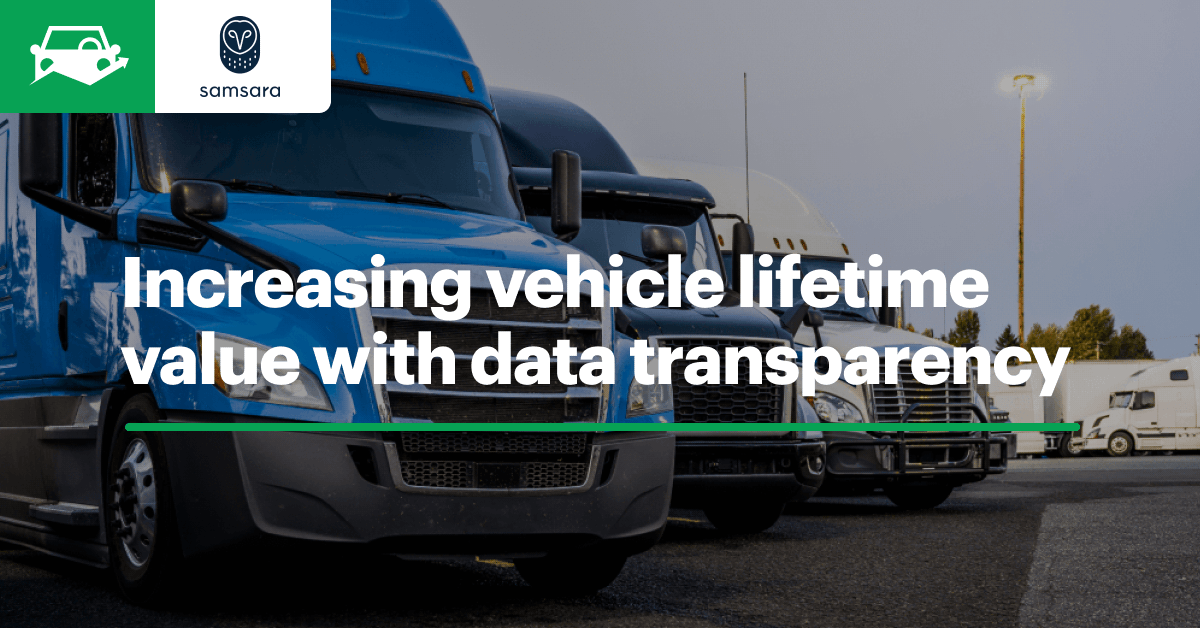Fleetio is proud to partner with top industry telematics providers, such as Samsara, to help our customers more effectively manage their fleet operations and to get the most out of their fleet data. As a trusted partner, we’ve invited Samsara to share their tips on how utilizing data can increase the overall value of your vehicles.

By: Neel Sheth, Director, Product Management at Samsara
The current economic climate has presented unique challenges to industries across the globe. This is no different for businesses with fleets, making it more important than ever to ensure your vehicles stay healthy and productive. A vehicle in the shop versus on the road can make the difference between a business that’s succeeding or just getting by.
But keeping vehicles well-maintained can be a complex process. Not only does it require insights into the health of each vehicle, but it also depends on the availability of resources, parts, and people at the right time. That’s why if you manage a fleet, it’s important to collect vehicle and driver data to simplify maintenance, minimize downtime and improve the utilization of your vehicles.
Read on to learn how your fleet can use real-time telematics data to help keep preventative maintenance schedules on track, identify and correct pending failures before a vehicle goes out of service and leverage driver feedback to efficiently detect and track discrepancies.
Leverage your fleet’s two main data sources: the vehicle and driver
Vehicles are a big investment. Upfront costs can be steep, but the expectation is that these vehicles will last you well into the future. And while it may be tempting to defer routine maintenance or overlook a minor recurring fault—especially when your vehicles are performing well—lapses in sound maintenance practices can put the lifespan of your fleet at risk.
But keeping track of when preventative maintenance actions are due and what discrepancies are logged against each vehicle can be a time-consuming and tedious task. Thankfully, the amount of telematics data available to fleet managers can help address these challenges, ensuring your vehicles stay in service and on the road.
Preventing unplanned downtime, which can cost anywhere from $448 to $760 a day, can be accomplished by leveraging vehicle and driver data:
1. Vehicle Data
Vehicle health starts with understanding what’s happening under the hood of each vehicle. That data can be sourced in two ways: directly from the vehicle’s diagnostic port or via an original equipment manufacturer (OEM) cloud integration. Both provide an accurate read on important data points like mileage, engine hours, fault codes, battery health, and more.
2. Driver Data
Drivers play a large part in vehicle performance—both in terms of how they operate the vehicle and what information they share about the vehicle. Some driver behaviors like speed, idling and torque can have a major impact on vehicle health, making it important to understand and analyze these habits to help reduce costs and minimize vehicle wear and tear.
Vehicle inspections, which are also carried out by drivers, are crucial in centralizing information about vehicle performance and outstanding vehicle defects.
Surface data insights to improve maintenance programs, avoid breakdowns and identify issues
Sourcing this data is only the first step. An advanced telematics system that can surface insights from vehicle and driver data to help make it valuable and actionable to your team can improve your maintenance—and bottom line. Here are three ways you can do that with Samsara:
1. Run a data-driven preventative maintenance program
Adhering to OEM recommended preventative maintenance schedules is critical to keeping your vehicles on the road. But with maintenance needs that depend on varying time intervals, mileage, and engine hour requirements, it can be challenging to keep track of when a vehicle is due in the shop.
By connecting your preventative maintenance schedule directly to your vehicle data, you can ensure you are notified when a vehicle is due for its next maintenance interval. This insight, alongside utilization reporting, can alleviate the risk of overusing high-performing vehicles so you can better allocate resources and vehicle use to ensure the long-term health of your fleet.
2. Leverage diagnostics data to avoid breakdowns
Understanding what’s going on under the hood of each of your vehicles in real time can help you identify an issue before it leads to a breakdown. And for some things, like a critical check engine light or a high oil temperature warning, a lag of only a few minutes can cause irreversible damage to your vehicles—costing you in downtime or potentially vehicle replacement.
Whether you leverage that information through OEM telematics or a telematics device, like the Samsara Vehicle Gateway, you can leverage remote access to critical diagnostics information like historical Diagnostic Trouble Codes (DTC). Stay up-to-date on this information in Fleetio with real-time alerts that help you diagnose pending failures before they result in unscheduled maintenance or worse, a call to roadside assistance.
3. Use driver feedback to identify issues
By using a telematics system, not only can your drivers more efficiently complete Driver Vehicle Inspection Reports (DVIRs), or walkaround inspections, but communication between drivers and maintenance staff becomes more automated—providing a real-time picture of vehicle health both pre- and post-trip.
When a discrepancy is identified in an inspection, you can immediately alert your maintenance team or automatically create a work order in your maintenance system via an API integration. Cross-referencing this information with a preventative maintenance schedule and diagnostics data allows your maintenance team to stay up-to-speed the next time a vehicle comes into the shop.
Manage your fleet maintenance with Samsara + Fleetio
Integrating Samsara with Fleetio’s maintenance platform makes it simple for your fleet to reduce downtime, improve utilization, and make maintenance a priority. With tools that help you analyze data from your vehicles and drivers, you can gain actionable insights that help automate vehicle health.
Samsara’s plug-and-play hardware and intuitive software pulls engine data in real time to quickly identify issues, monitor vehicle performance, schedule regular check-ups, and track historic vehicle faults to inform procurement and utilization plans.
Fleetio’s integration with Samsara makes it possible for shared customers to sync key maintenance data between both programs—such as odometer readings, fault codes, and DVIR exceptions—to help improve preventative maintenance workflows and full lifecycle cost reporting. By bringing Samsara data into Fleetio, customers can also leverage this data to create reports that can be easily customized, saved, scheduled and exported.
To learn more about the Samsara & Fleetio integration, check out the Fleetio App Directory.



